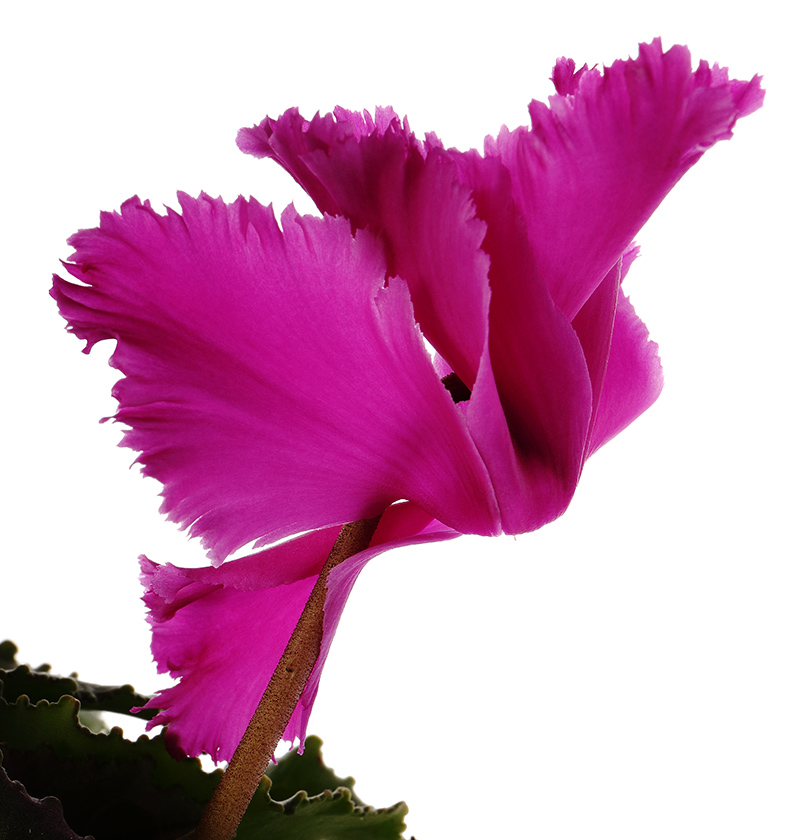During the winter I’m glad to be able to photograph plants indoors. It feels good to be able to stay warm and dry! And life is much easier when there’s no need to worry about the flower you’re trying to photograph waving around in the wind.
More importantly, taking photos indoors means that there is plenty of light available to me. I have a very small studio space set up in the house, complete with flash lighting, which allows me to be busy taking photographs at any time of day.

The photographs here were taken with a very simple setup. The white background is created using a small ‘light table’, which is basically a piece of translucent white plastic which is curved into an ‘L’ shape on a metal support. This gives a base and background that is lit with flash strobes both from behind and from below. These are adjusted to give an evenly lit bright white background to the photo.
The flower itself is lit with a flash fired through a white translucent brolly and a reflector at the side to provide a little bit of light to soften shadows. I like using this particular arrangement because it gives a slightly ‘harder’ light than the softbox that I’ve used for previous photos on this blog. This helps to bring out the shapes within the flower and gives a feeling of depth.

Having the flash pretty much to one side of the flower means that shadows can form in the ripples on the petals. If you look at the photograph below, you can see that there is a slight shine to the area at the centre of the flower, on the left side. This shows where the light is coming from. (More or less at a 45 degree angle, slightly higher than the flower and only just in front of it.)
If there wasn’t a reflector (a silver-coloured disc) at the right side, that side would be in shadow. The reflector is just enough to lighten heavy shadows without removing the shadows entirely, so you’re able to see the flowing shapes of the petals.
Digital photography has made using studio lighting far easier than it was with film cameras. (For years I used film, and I tended to stick with safe setups that I new would work.) Experimenting is easy when you can see the results straight away and you can soon find what happens when you move the lights around.
So when the weather’s turned miserable, I’m quite happy to be indoors, so long as I can find something to photograph…


The ruffles and swirls do make them like flamenco dancers! Beautiful.
LikeLiked by 1 person
Thanks Liz! They are very small flowers but with a lot of detail in all those crinkles and folds – great for photography!
LikeLiked by 1 person
They are gorgeous, Ann!! You are an expert photographer!!
I am with bare minimum photographic gear 😀 😀
LikeLiked by 1 person
Thank you for your kind comment, Indira! I was lucky enough to be able to go back to college as a mature student and study photography. That allowed me to learn about using studio lighting and lots more – I loved it! 🙂
LikeLike
I had commented on this…still, I don’t see it here!
Pls check your spam, Ann
LikeLiked by 1 person
I’m late getting up today so late in getting online. I’ve become a bit of a night-owl over the winter and tend to publish my posts very late at night, then go to bed. Hope I can get back to normal hours before spring and the good light mornings! 🙂
LikeLiked by 1 person
So beautiful, so clever – looks far from simple a technique to me! Perfect description, flamenco..
LikeLiked by 1 person
Thanks Phao! I was lucky enough to be able to study photography and had good teachers… 🙂
LikeLiked by 1 person
Those ruffled petals are great for photography and your use of lighting with the high key background really sets them off well, Ann.
LikeLiked by 1 person
Thanks Steve! It’s something I really enjoy doing. 🙂
LikeLike
Flamenco dancers is right, and brings a touch of the exotic, and warmer times to come. You certainly have an in depth understanding of light and shadow.
LikeLiked by 1 person
Thanks Jill! I enjoy small-scale studio photography with plants and have just been getting back to it over the last couple of years. 🙂
LikeLiked by 1 person
Those are incredible floral images Ann! Enjoyed reading about your studio set up to take them. I have not gotten too much into inside shooting. It sounds like you have the perfect set up to do this and it creates some fabulous results! Look forward to some more of your studio shots!
LikeLiked by 1 person
Thanks Syd! I like working in my tiny ‘studio’ – but it can be a bit cramped at times because the lights take up a lot of the space. It lets me keep taking photographs when there’s not much light outside. 🙂
LikeLiked by 1 person
Never seen ruffled cyclamen before – amazing pics!
LikeLiked by 1 person
Thank you! I think that they’re fairly new. I had a relatively curly one before, but these are much more crinkled. The flowers are very small, so it means I get as close as I can. 🙂
LikeLiked by 1 person
Exquisite!
LikeLiked by 1 person
Thank you! Glad you liked them – I enjoyed photographing them. 🙂
LikeLiked by 1 person
Woah! These are incredibly beautiful! 🤩
Amazingly captured!
Stay safe, strong and sane!🍁
-theinkwarrior
LikeLiked by 1 person
Thank you! I’m glad you liked them. 🙂 They were great to photograph. Hope you’re staying safe and well too!
LikeLiked by 1 person